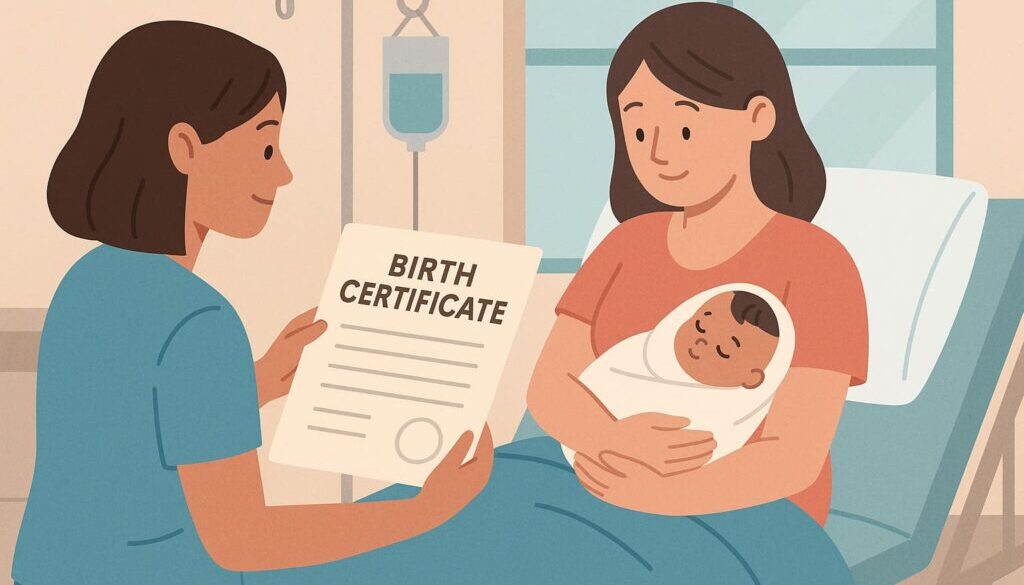Birth certificate before hospital discharge
Table of Contents:
India is moving toward a “one-step, one-document” birth-registration regime: hospitals (public + private) must now e-file the child’s details before the mother is discharged, triggering a digital birth-certificate that becomes the sole official proof of date-of-birth for passports, school entry, Aadhaar seeding and more. The change rests on four static pillars you must know for UPSC—(1) the original Registration of Births & Deaths Act 1969, (2) its 2023 amendment, (3) the Civil Registration System (CRS) architecture run by the Registrar-General of India, and (4) constitutional scaffolding: Article 21 (life + dignity = identity) and List III Entry 30 (“vital statistics”). Mastering these permanent rules lets you tackle any dynamic question that spins off from the current circular.
Birth-certificate before hospital discharge: what changed and why
-
Policy move – The Office of the Registrar-General of India (ORGI) issued a circular on 12 June 2025 directing hospitals to generate and hand over the digitally signed birth certificate before the mother leaves the facility.
-
Rationale – Early, electronic capture tackles three chronic gaps: (i) under-reporting of births, (ii) fake certificates, and (iii) long queues at municipal offices.
-
Down-stream effects – From 1 October 2023 the amended law makes this single certificate mandatory for passports, school admissions and government jobs. Many states are already integrating hospital MIS with the CRS portal (e.g., Karnataka’s eJanma, Rajasthan’s Pehchan) so parents walk out with a QR-coded PDF on their phone.
Registration of Births & Deaths Act 1969 (RBD Act)
Key architecture
-
Enacted under Parliament’s power over “vital statistics” (List III, Entry 30).
-
Creates a four-tier hierarchy—Registrar-General of India → State Chief Registrars → District Registrars → Local Registrars (municipality/PHC).
-
Makes registration compulsory within 21 days; delayed entry after 30 days needs a magistrate’s order and late fee (ss. 13-15).
-
Provides for searches, extracts, corrections, penalties for non-registration, and even overseas events (s. 20).
2023 Amendment Act: what’s new
-
Digital-first register – Replaces “extract” with an electronic certificate admissible everywhere.
-
National & State population database – ORGI will maintain a live, inter-linked register; state databases must sync daily.
-
Single-source document – The certificate is now ipso facto proof for Aadhaar, school enrolment, voter rolls, driving licence, marriage & property deals.
-
Effective date – All provisions enforced from 1 October 2023 by Home Ministry notification.
Civil Registration System (CRS) – how the plumbing works
CRS is “continuous, permanent, compulsory & universal” recording of births, deaths and still-births—producing vital statistics for health planning and SDG tracking.
Article 21: life → dignity → identity
-
Puttaswamy (2017) held privacy, autonomy and identity are intrinsic to life & dignity under Art 21.
-
The Aadhaar ruling (2018) reaffirmed that proof-of-identity documents are essential to access welfare rights.
-
Delhi HC (2024): “the right to be identified by one’s name is fundamental to identity” when ordering CBSE to correct a father’s name on certificates.
-
These judgments anchor the policy: denying or delaying a birth certificate impairs constitutional rights to dignity, education and movement.
Federal matrix – List III Entry 30 & State Rules
-
Because “vital statistics” sit in the Concurrent List (Entry 30) Parliament can legislate nationwide standards (1969 Act, 2023 Amendment) while states frame operational Rules—forms, fees, language, local timelines.
-
In case of a clash, Article 254 makes the central Act prevail unless the state law gets presidential assent—hence hospitals must now comply with the 2025 discharge directive even if older state by-laws allow 21-day filing windows.
-
States retain room to customise tech stacks (e.g., blockchain in Karnataka, multilingual front-ends in Rajasthan) so long as data syncs with ORGI each day.
Take-away for UPSC
-
Static first, current later – Remember section numbers, hierarchy and constitutional hooks; the news is merely the trigger.
-
Link answers – For a polity Mains question on federalism you can weave: Art 254 override + List III Entry 30 + 2023 digital-register clause.
-
Data pointer – Quote CRS 2020 under-registration rate (7.5 %) or Karnataka’s 100 % e-registration milestone to enrich answers




